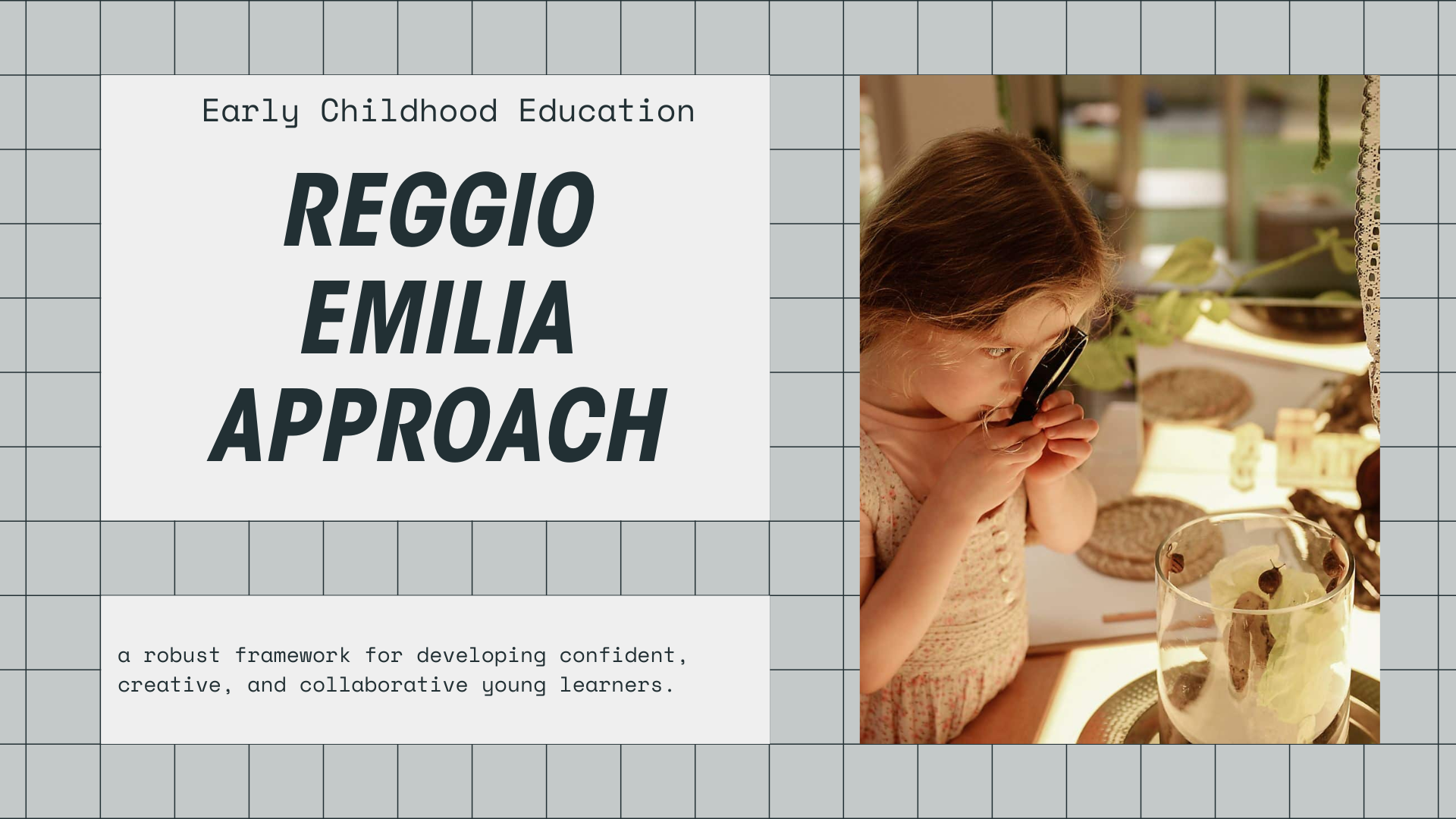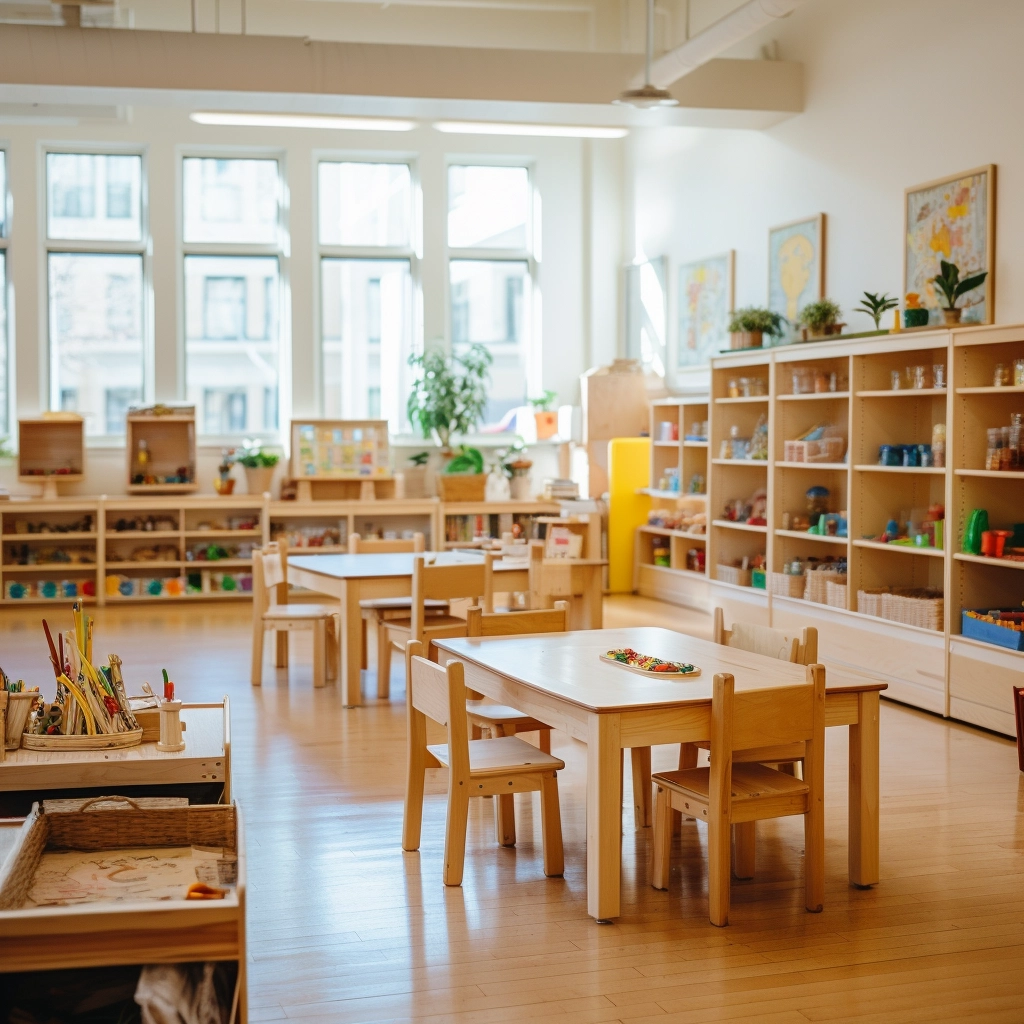Are you frustrated with early education models that treat children as passive recipients of knowledge? Do you feel that traditional classrooms are too structured, too uniform, and not conducive to genuine curiosity? Why do some kindergartens raise innovative, confident thinkers, while others churn out compliance and conformity?
The Reggio Emilia Approach is more than an educational philosophy; it is a robust framework for developing confident, creative, and collaborative young learners. Rooted in respect for the child as an active constructor of knowledge, the Reggio Emilia Approach empowers early learners to explore, express, and engage deeply with their environment. It transforms classrooms into living laboratories of discovery, where children’s ideas lead the way and teachers act as partners in their growth.
If you’re designing a preschool that inspires imagination, nurtures critical thinking, and values each child’s voice, the Reggio Emilia Approach isn’t optional. It’s essential.
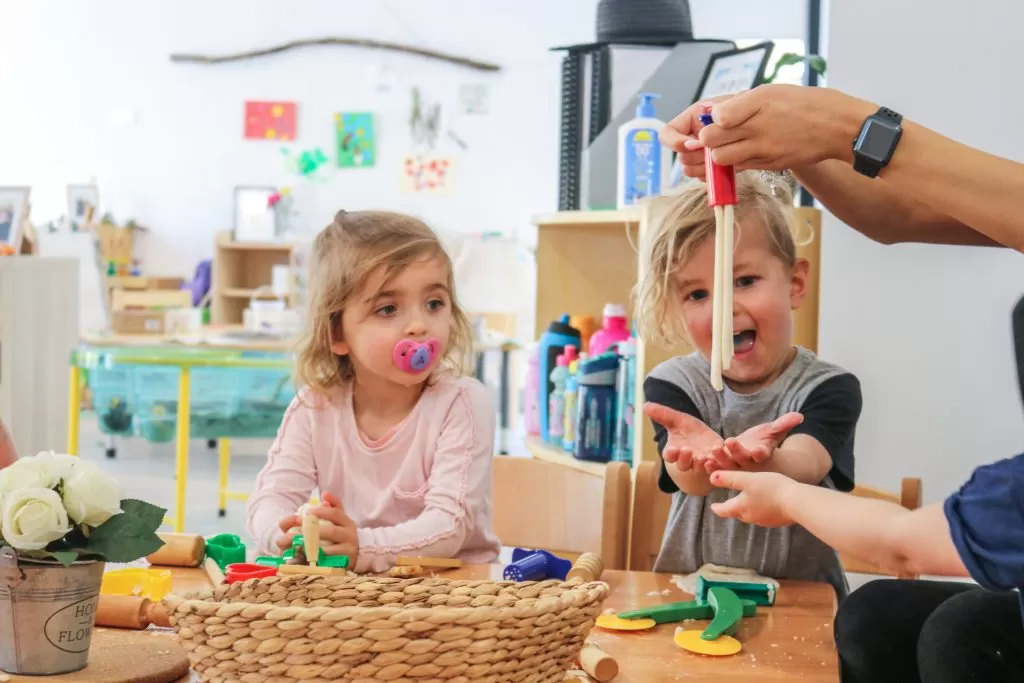
ما هو نهج ريجيو إميليا؟
The Reggio Emilia approach offers a distinctive perspective on early childhood education, rooted in respect for the child as an active participant in their own development. It invites educators and families to rethink traditional roles and see learning as a dynamic, collaborative journey.
ريجيو إميليا نهج الفلسفة
The Reggio Emilia approach is a child-centered educational philosophy that views children as strong, capable, and full of potential. Originating in Reggio Emilia, Italy, after World War II, it is grounded in the belief that children construct their knowledge through meaningful interactions with their environment, peers, and adults. This approach emphasizes hands-on, project-based learning, where children are encouraged to explore their interests through multiple forms of expression—such as art, music, movement, and dramatic play. Teachers act as facilitators and keen observers, documenting the learning process and collaborating with children to deepen understanding.
تاريخ وأصل نهج ريجيو إميليا
The Reggio Emilia Approach originated in Reggio Emilia, Italy, after World War II. The community, devastated by the war, sought to rebuild a more just and democratic society, starting with early childhood education.
وفي قلب هذه الحركة التعليمية كان لوريس مالاجوزي، ال مؤسس نهج ريجيو إميلياكان مالاجوزي عالم نفس ومعلم، وتصور مدارس يُنظر فيها إلى الأطفال باعتبارهم مشاركين نشطين في بناء المعرفة، وليسوا متلقين سلبيين للتعليمات.
على مر العقود، تطور هذا النهج ليصبح نموذجًا تعليميًا يحظى بالاحترام عالميًا. وقد أثّر تركيزه على الإبداع والتفكير النقدي والعلاقات الهادفة على رياض الأطفال في أوروبا وأمريكا الشمالية وخارجها.
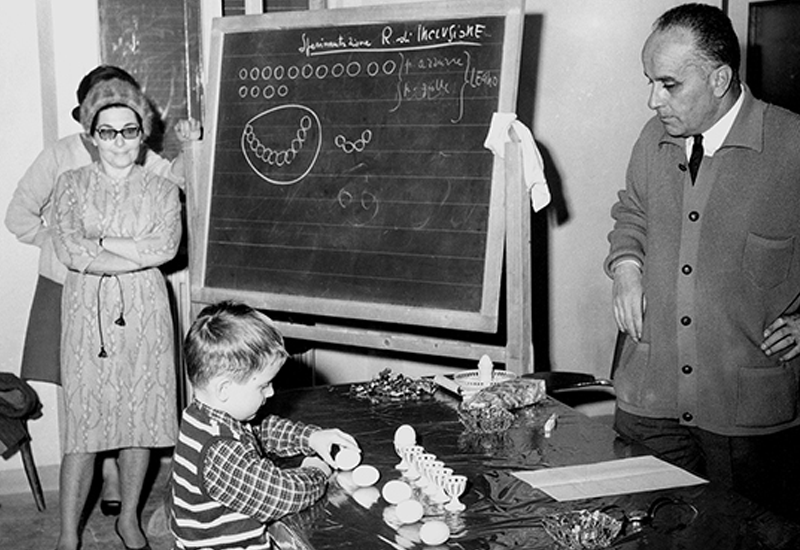
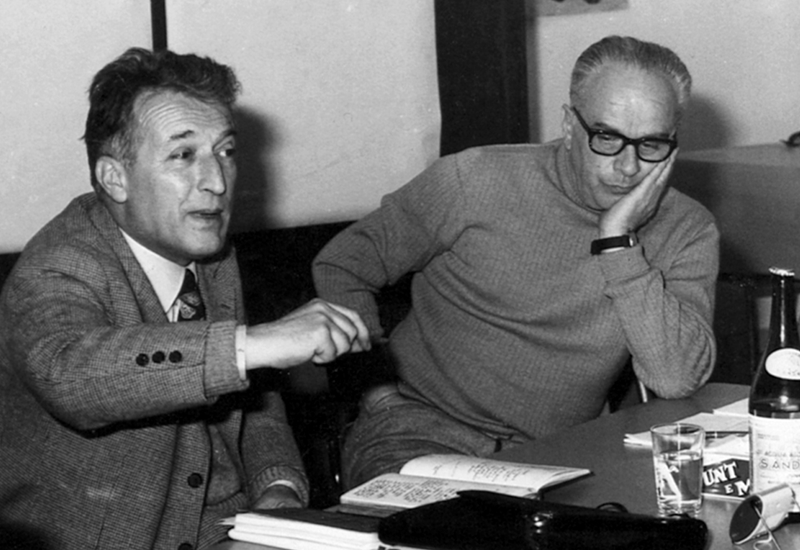
نهج ريجيو إميليا مقابل مونتيسوري
The Reggio Emilia Approach and the Montessori Method are child-centered but differ in educational structure and philosophy. Reggio is inquiry-driven and collaborative; Montessori is structured and focused on independent mastery of materials.
| وجه | نهج ريجيو إميليا | طريقة مونتيسوري |
|---|---|---|
| أسلوب التعلم | المشاريع الناشئة القائمة على المشاريع | متسلسل، قائم على المهارة |
| دور المعلم | المتعلم المشارك والمتعاون | المرشد والمراقب |
| بيئة | جمالية، مرنة، موجهة للأطفال | منظم، يركز على المواد |
| تعبير | لغات إبداعية متعددة | المواد الحسية المحددة |
| تقدير | التوثيق والحوار | الإتقان من خلال الملاحظة |
Both approaches respect the child as an active learner. The right choice often depends on the educational focus on creative collaboration or structured independence.
Key Principles of the Reggio Emilia Approach
The Reggio Emilia Approach is built on a foundation of guiding principles that shape every aspect of the learning environment. These principles go beyond teaching techniques; they reflect a deep respect for children’s rights, capabilities, and ways of knowing.
فيما يلي تفصيل موجز للمبادئ الأساسية، مرتبة من الأفكار الأكثر أهمية إلى الأفكار الداعمة، وفقًا لأسلوب الكتابة الهرمي من أجل الوضوح والتأثير.
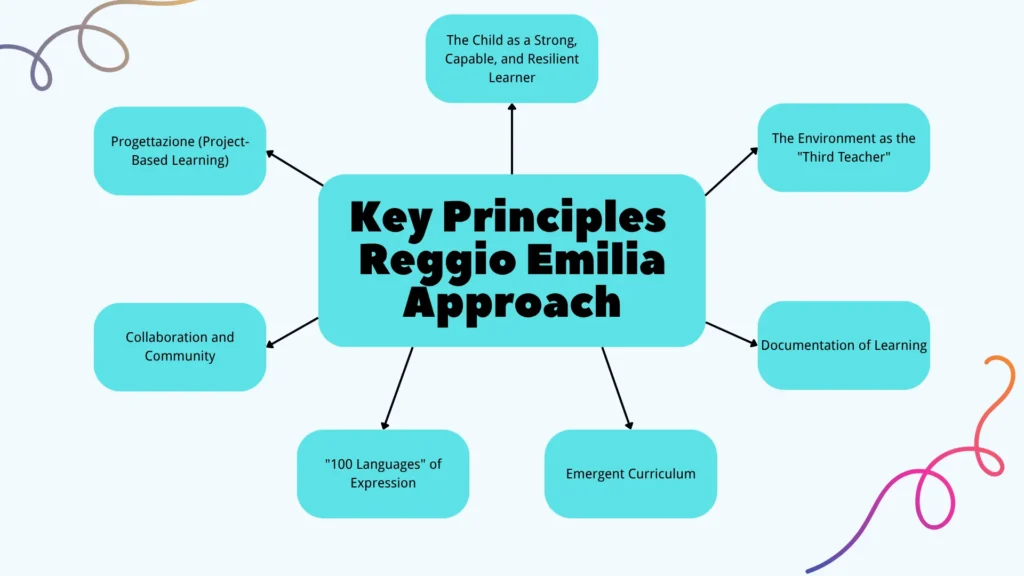
1. The Child as a Strong, Capable, and Resilient Learner
Children are viewed as competent individuals with the ability to construct their knowledge. They are not passive recipients of instruction, but active explorers with personal agency. Educators respect children’s ideas, encourage inquiry, and support learning through dialogue, reflection, and experimentation.
2. The Environment as the “Third Teacher”
The physical environment intentionally promotes exploration, autonomy, and interaction. Natural light, open-ended materials, and aesthetically considered spaces support focus, creativity, and collaboration. The classroom teaches, offering cues, challenges, and learning opportunities.
3. Documentation of Learning
Educators systematically observe and document children’s learning processes using photographs, transcriptions, and video recordings. This documentation is a tool for reflection, planning, and family communication. It makes children’s thinking visible and provides continuity and depth in curriculum development.
4. Emergent Curriculum
Curriculum arises from children’s interests and inquiries rather than from predetermined topics. Teachers observe children closely, identify themes in their play or questions, and then co-construct learning experiences that expand and deepen those interests. This approach maintains developmental relevance and student engagement.
5. The “Hundred Languages” of Expression
The approach recognizes that children express their understanding in multiple symbolic forms — visual arts, movement, music, storytelling, construction, and more. These forms are not secondary to verbal language; they are essential tools through which children represent, test, and refine ideas.
6. Collaboration and Community
Learning is considered a relational process. Children learn in interaction with peers, teachers, families, and the broader community. Cooperation, dialogue, and shared problem-solving are emphasized. Families are active participants in school life, and their involvement is integral to the educational experience.

7. Progettazione (Project-Based Learning)
Children engage in extended investigations, often collaboratively, centered on topics that emerge from their expressed interests. These projects support sustained inquiry and integrate multiple domains of learning. Teachers guide the process by introducing materials, posing questions, and helping children reflect on their work.
هل أنت مستعد لتصميم مساحة تُلهم التعلم؟ تواصل معنا لتصميم حلول أثاث مُخصصة تُلبي احتياجات صفك الدراسي.
فوائد نهج ريجيو إميليا
The Reggio Emilia Approach is a practical, proven framework that delivers deep and lasting benefits for children, educators, and families. Its child-centered, inquiry-driven nature unlocks real developmental advantages that traditional models overlook.
1. يعزز الإبداع والتفكير النقدي
One of the Reggio Emilia Approach’s greatest strengths is its ability to cultivate creative, independent thinkers. Instead of memorizing facts or completing predefined tasks, children are invited to explore real-world questions that emerge from their curiosity.
By encouraging experimentation, self-expression, and open-ended inquiry, the approach helps children develop a flexible, problem-solving mindset. They learn to test ideas, make decisions, and reflect. Creativity here is not a separate subject. It’s embedded in every interaction, every project, and every material children engage with.

2. يعزز المهارات الاجتماعية والتواصلية
Children in Reggio-inspired classrooms constantly engage in conversation, group work, and collaborative decision-making. These interactions sharpen communication, listening, and negotiation skills from a very early age.
This collaborative environment encourages empathy and respect. Children learn to consider other perspectives, articulate their thoughts clearly, and find shared solutions within a socially supportive setting. Such skills are essential for academic success and navigating relationships in both school and life.
3. يشجع الذكاء العاطفي والتنظيم الذاتي
The Reggio Emilia Approach integrates emotional growth into the learning process. Under the guidance of observant educators, children are encouraged to express feelings, navigate challenges, and reflect on their emotional experiences.
Rather than disciplining behavior reactively, teachers help children understand their emotions, make thoughtful choices, and resolve conflicts with respect and autonomy. This builds stronger self-awareness and emotional resilience. As a result, children become more secure in themselves and better equipped to manage frustration, adapt to change, and build positive relationships.
4. يعمق المشاركة والدافعية
Because learning is based on what children care about, their focus and enthusiasm naturally increase. They are not simply following instructions; they are actively driving their learning journey. This sense of ownership fuels intrinsic motivation.
Children in Reggio-inspired environments show more persistence, initiative, and joy in their work. They dig deeper into topics, stay engaged longer, and take pride in their creations and discoveries. The Reggio Emilia Approach often leads to deeper understanding and better retention than traditional instruction.
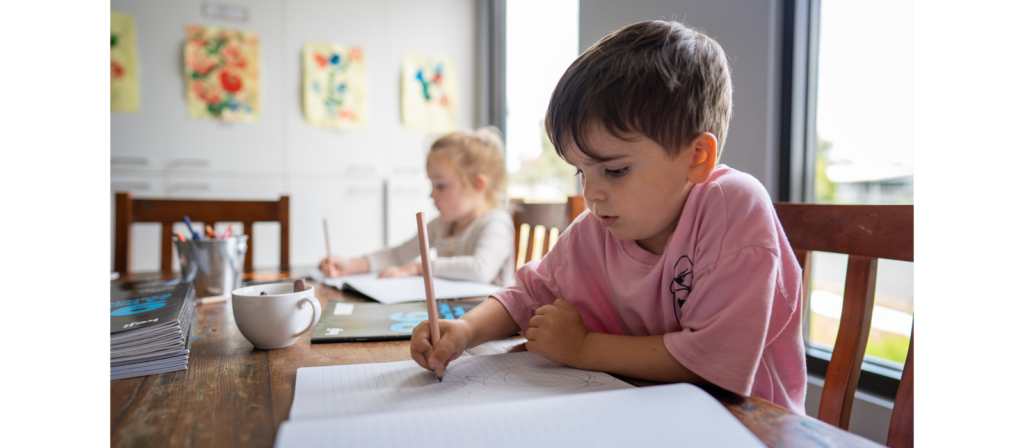
5. يبني شراكات قوية مع أولياء الأمور
It values and integrates parents into the educational process. Families are not just informed but invited to participate, observe, and contribute. Through transparent communication, documentation of learning, and regular involvement, parents gain a clearer view of their child’s development.
This strengthens trust and builds a learning community around the child that extends from school to home. Children feel more supported and connected when families feel seen and included, and their growth accelerates meaningfully.
بيئة الفصل الدراسي في منهج ريجيو إميليا
Referred to as the “third teacher”, the physical environment plays a central role in shaping how children explore, interact, and make meaning. Every element in the space is intentionally chosen to support inquiry, collaboration, and aesthetic appreciation.
1. مساحة تعكس الطفل
Reggio-inspired classrooms are designed to feel like homes, studios, and laboratories combined. They are warm and welcoming and filled with natural light, plants, open shelving, and real-world materials. This design signals to children that they are respected and that their surroundings are worthy of care and attention.
Children can access a wide range of open-ended materials — such as fabric, clay, wood, wire, stones, and mirrors — inviting creativity and experimentation. Unlike traditional classrooms focusing on plastic toys or rote tools, these environments support flexible thinking and imaginative play.
Significantly, the classroom evolves. As children explore new interests, materials, and layouts are adjusted to reflect their questions and discoveries. In this way, the environment becomes a living expression of the children’s learning journey.
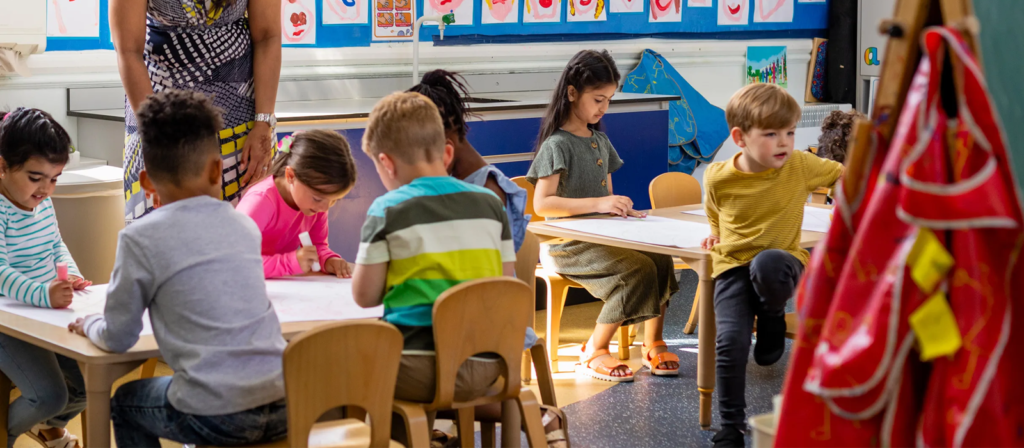
2. الشفافية، وإمكانية الوصول، والجمال
A hallmark of the Reggio Emilia classroom is literal and figurative transparency. Glass walls, interior windows, and display panels are common, allowing visibility between spaces and making learning visible to others. Children can observe peers in other rooms, teachers can monitor interactions, and families can witness the learning process unfolding.
Materials and tools are placed at child height, fostering independence and autonomy. Open shelves allow children to choose resources freely. Display areas showcase not only finished work but also learning in progress, including drawings, drafts, conversations, and questions. This reinforces the idea that the process is just as important as the product.
The aesthetics of the space matter deeply. A beautiful environment communicates value. It inspires children to take pride in their work and to engage more thoughtfully with their surroundings. This principle, that beauty invites learning, is one of the most distinct characteristics of the Reggio Emilia Approach.
3. Flexible Spaces That Support Movement and Possibility
A Reggio Emilia classroom is intentionally designed to support movement, flexibility, and multiple layers of use. Rather than assigning rigid functions to fixed areas, the space invites transformation throughout the day. A reading corner may become a theater stage, a science table may turn into a construction zone, and a quiet area may evolve into a site for collaborative storytelling. This adaptability empowers children to reimagine how they use the environment based on their interests and intentions.
The Reggio-inspired layout promotes open circulation. Pathways are clear, wide, and unobstructed, allowing children to move freely between individual work, small group projects, and whole-class gatherings. Materials are organized in ways that encourage spontaneous use, and furniture is light and rearrangeable to support shifting group sizes and learning modes. Instead of confining children to specific stations, the environment offers a continuous flow that mirrors the way children naturally explore.
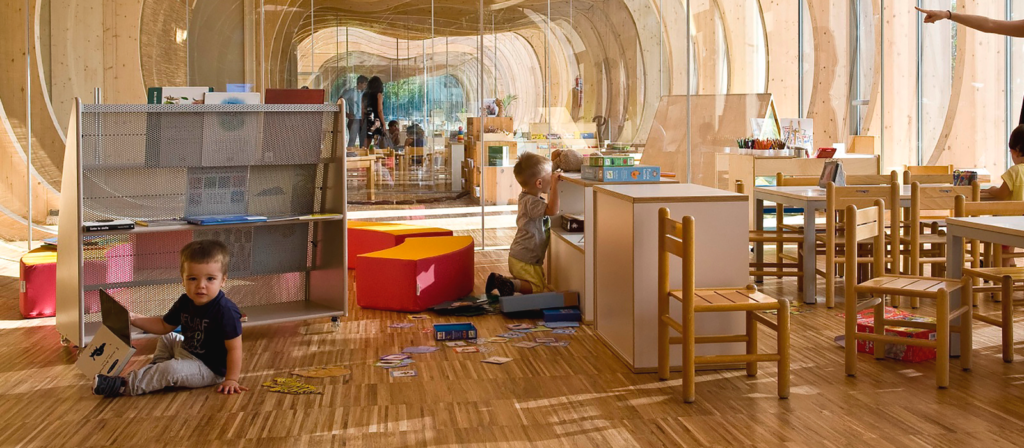
This fluid and layered design nurtures autonomy, decision-making, and self-regulation. Children learn to navigate space with purpose, make choices about where and how to work, and adapt their thinking as contexts change. The result is a dynamic classroom where the environment itself becomes a partner in discovery, supporting learning that is physical, intellectual, and creative all at once.
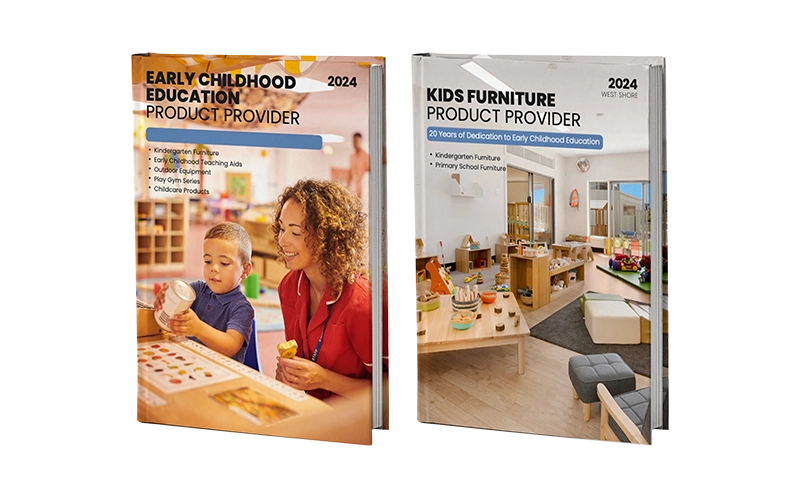
How to Define Spaces and Equip a Reggio-Inspired Classroom
Designing a Reggio-inspired classroom begins with the belief that the environment plays an active role in a child’s learning journey. Every space should reflect intention, purpose, and flexibility, allowing for both individual exploration and group collaboration. Rather than filling a room with furniture and materials, educators define each area with care, guided by how children move, interact, and express themselves.
1. Begin with the Child’s Perspective
Start by observing how children move, play, and interact. Consider their eye level, their reach, and the way they engage with their surroundings. All furniture, shelving, and materials should be placed to support independence. The room should feel welcoming, not overwhelming. By designing from the child’s point of view, the environment immediately becomes more accessible, comfortable, and empowering.
2. Define Learning Zones with Intention and Flexibility
Divide the room into zones that support different types of learning experiences. These might include an atelier for artistic expression, a construction area for building, a reading nook for quiet time, and a science table for exploration. Use soft spatial markers such as rugs, shelving, or lighting changes to separate zones without blocking flow. Keep in mind that zones should not be static. They can evolve, blend, and shift over time.
3. Choose Flexible, Natural Furniture That Supports Autonomy
The right furniture does more than fill a space — it defines how children interact with it. At أثاث ويست شور, we produce preschool and kindergarten furniture specifically tailored to Reggio-inspired environments. Our designs prioritize modularity, accessibility, and natural aesthetics, using wood textures, smooth finishes, and rounded forms that invite exploration. Open-shelf units, mobile storage, adjustable tables, and seating scaled to the child’s body enable children to independently access materials, transition between zones, and manage their learning process. In the Reggio Emilia philosophy, furniture is not passive — it’s a pedagogical tool that quietly encourages agency and curiosity.
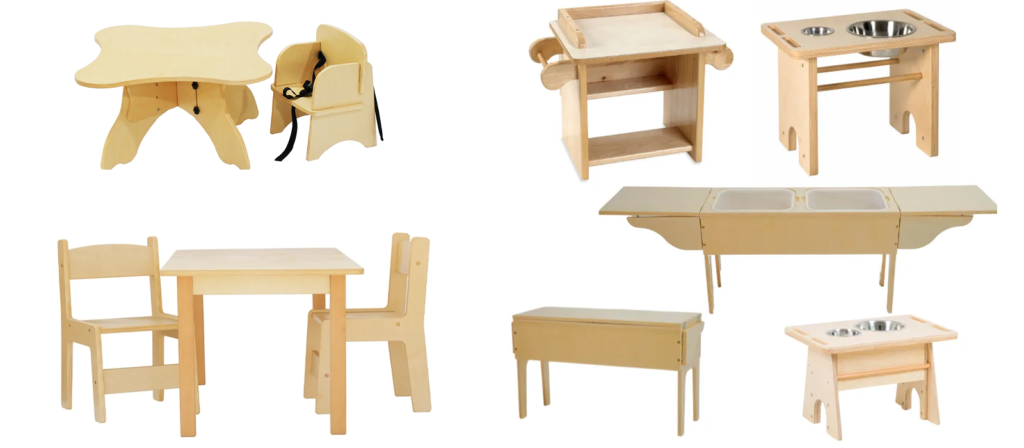
4. Creating Soft Boundaries for Flow
In Reggio Emilia classrooms, space isn’t static — it’s responsive. Defining learning zones starts by observing how children naturally move, gather, and explore. Rather than using fixed dividers or barriers, educators create “soft boundaries” using child-height shelving, rugs, lighting, and material displays. These visual and functional cues gently suggest purpose without limiting flexibility. The layout must support visibility, collaboration, and the child’s autonomy, essential values in the Reggio Emilia Approach. A thoughtful arrangement allows the environment to become an active participant in learning, rather than just a backdrop.

5. Equip Each Zone with Open-Ended, Purposeful Learning Materials
Beyond layout and furniture, the tools within each zone give meaning to the space. We offer a range of educational materials — including natural blocks, loose parts kits, sensory trays, mirror panels, and light table tools — designed to support creativity, scientific observation, and expressive play. These open-ended materials allow children to represent their thinking across disciplines and in multiple “languages,” a concept central to the Reggio Emilia Approach. Whether a child is documenting shadows, constructing habitats, or telling visual stories with clay, the right tools turn the environment into a place of endless possibility.
6. Allow the Environment to Evolve
A Reggio-inspired classroom is never static. As children’s interests change, the space must shift with them. Rearranging materials, rotating learning areas, or adding provocations based on new inquiries shows that the environment is alive. This flexibility supports curiosity and ensures that the classroom continues to reflect the children who inhabit it. A Reggio-inspired classroom is never finished. It is always in conversation with the children inside it.
المناطق الرئيسية في الفصول الدراسية المستوحاة من ريجيو
A Reggio-inspired classroom is not arranged by chance. Every space is intentionally designed to encourage exploration, collaboration, and creative expression. From the light and shadow center to the art studio, the classroom gives multiple pathways for children to communicate and learning. These zones are not rigid or static. They are flexible, evolving spaces that respond to children’s interests and inquiries.
1. الأتيليه (استوديو الفن)
The atelier is a central hub where creativity takes shape. It is filled with high-quality art materials, natural elements, and open-ended tools. It functions as a creative studio that values process over product, inviting children to paint, sculpt, build, and invent. Rich in texture, color, and possibility, the atelier supports cognitive, emotional, and sensory development while encouraging collaboration and individual expression through the many “languages” of art.
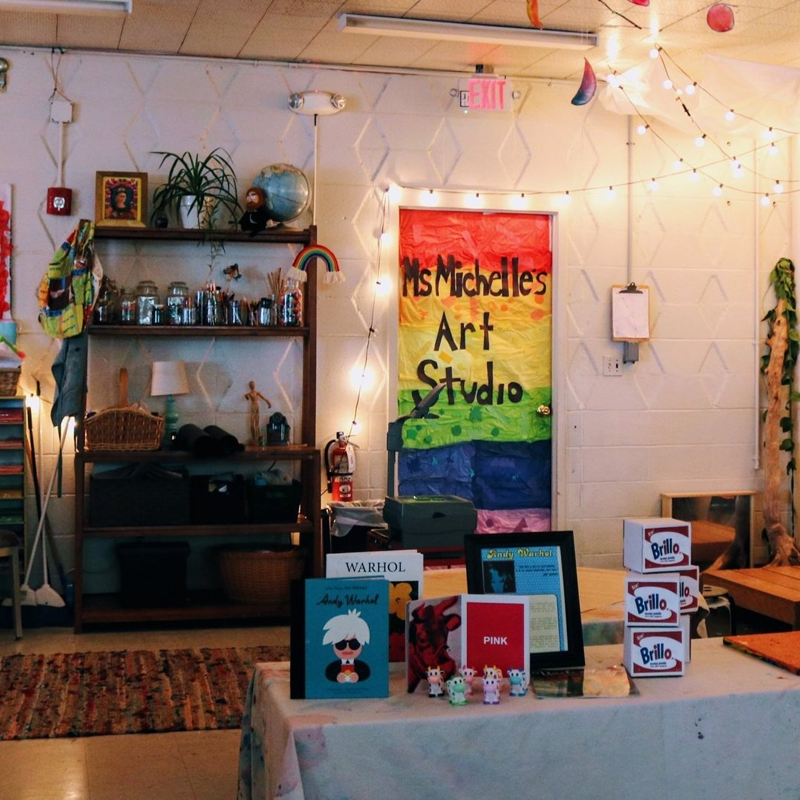
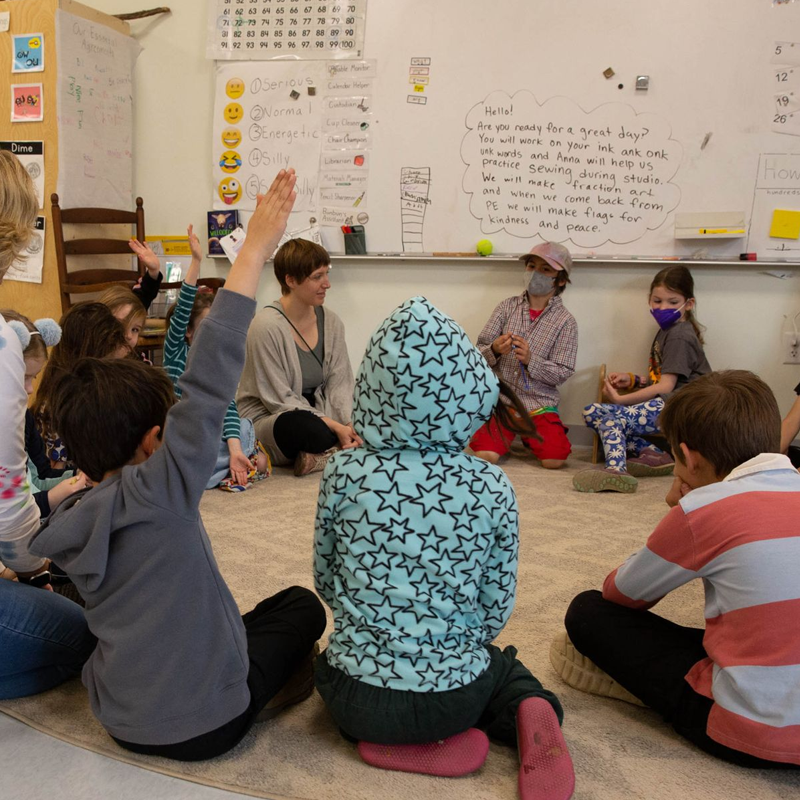
2. الساحة (منطقة الاجتماعات المركزية)
The Piazza serves as the social hub of the classroom. Inspired by the Italian town square, it is a shared space where children gather for conversation, group projects, morning meetings, and storytelling. It reflects the belief that learning is inherently social and that children benefit from sharing ideas within a community.
3. زوايا التعلم والمختبرات الصغيرة
Learning corners and mini-labs provide focused environments for inquiry into specific domains, such as science, construction, or storytelling. These smaller spaces encourage self-directed learning by allowing children to choose areas that align with their current interests. The design supports deep engagement, as children can explore materials and ideas without interruption. Children also build independence as they manage time and tools during exploration.
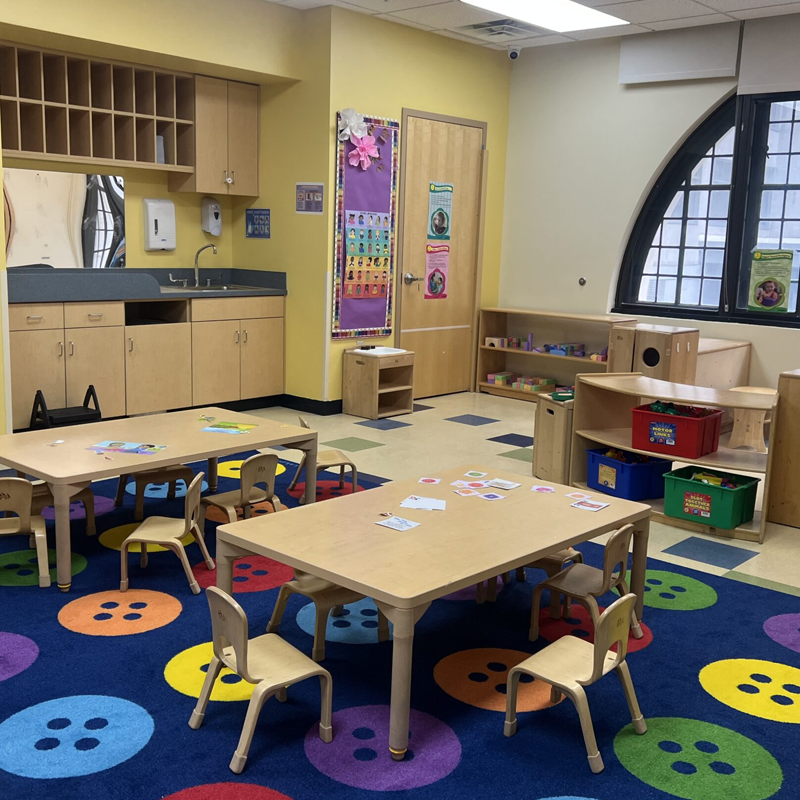

4. The Light and Shadow Center
Light is considered a powerful medium in Reggio-inspired learning. The light and shadow center gives children the chance to manipulate reflections, projections, and shadows, sparking curiosity about natural phenomena and abstract concepts. Through hands-on manipulation of light sources and materials, children engage in discovery and visual storytelling.
5. Quiet and Reflective Spaces
Quiet and reflective spaces respect each child’s rhythm by offering comfort and stillness within a busy classroom environment. These zones allow children to process their emotions, engage in individual reading or journaling, and build inner focus. By providing an intentional retreat, educators send the message that reflection is just as valuable as activity. Such spaces also support children in developing self-regulation and emotional awareness.
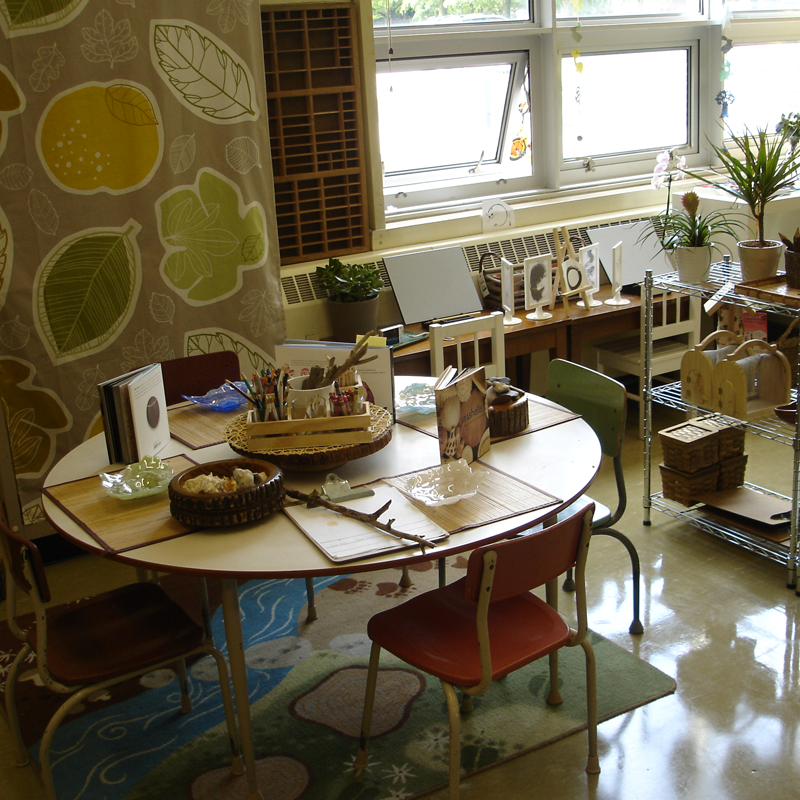
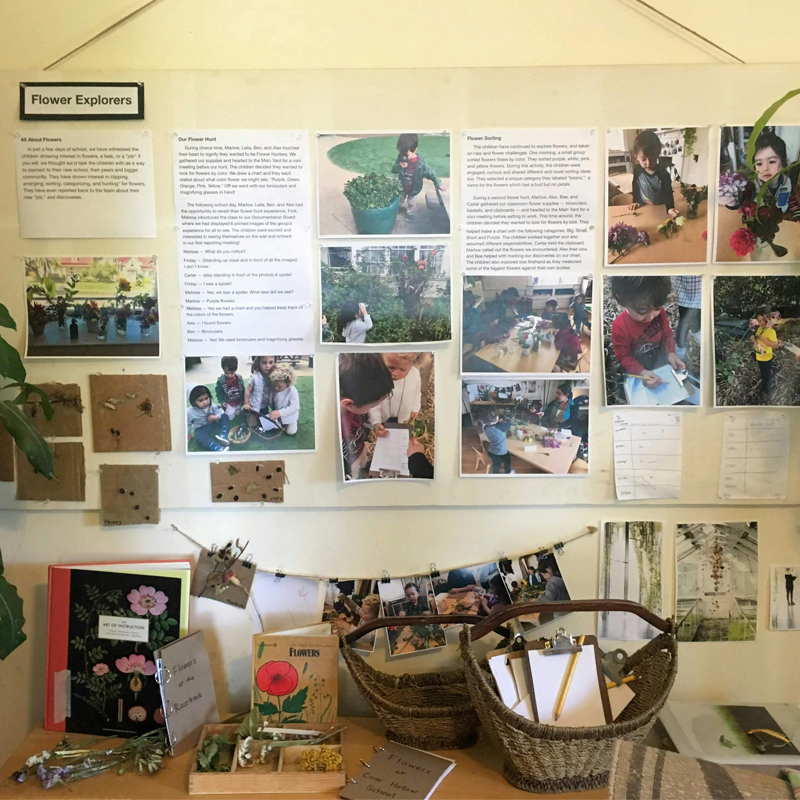
6. Display and Documentation Areas
Documentation is central to Reggio-inspired learning, and these areas serve as living records of children’s work. By displaying drawings and photos, teachers make the learning process visible to children, parents, and visitors. This practice not only validates children’s efforts but also encourages ongoing dialogue about their discoveries. Documentation areas evolve with projects, reinforcing that learning is dynamic, collaborative, and deeply connected to children’s experiences.
7. Natural and Outdoor Zones
Outdoor environments and natural zones are seen as extensions of the classroom, providing children with direct encounters with nature. Here, they engage with plants, weather, and natural materials, developing respect and curiosity for the living world. These spaces invite exploration of seasonal changes, life cycles, and environmental stewardship. By combining movement, sensory experiences, and observation, outdoor zones give children opportunities to learn holistically.
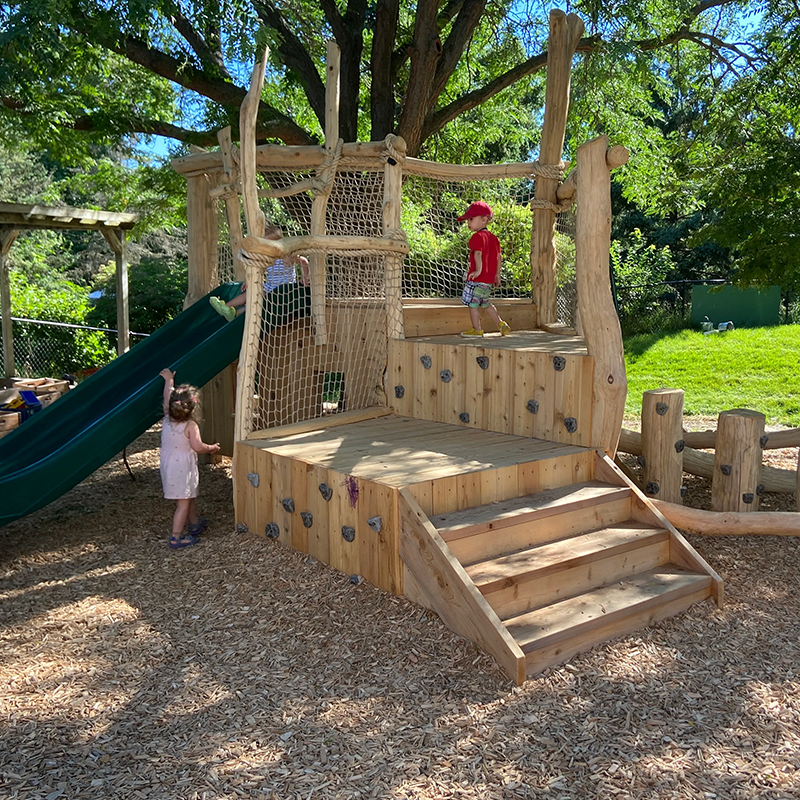
هل أنت مستعد لتصميم مساحة تُلهم التعلم؟ تواصل معنا لتصميم حلول أثاث مُخصصة تُلبي احتياجات صفك الدراسي.
Teacher’s Role in the Reggio Emilia Approach
في نهج ريجيو إميليا، لا يُعتبر المعلم شخصيةً تقليديةً ذات سلطة تُقدّم المعرفة من أمام الفصل الدراسي. بل يُنظر إليه كباحث، ومتعاون، ومستمع، ومُحفّز - شخصٌ يتعلم جنبًا إلى جنب مع الطفل، لا فوقَه. يُعدّ هذا الدور المُعاد تعريفه جوهريًا لنجاح فلسفة ريجيو، ويُميّزها عن التعليم التقليدي في مرحلة الطفولة المبكرة.
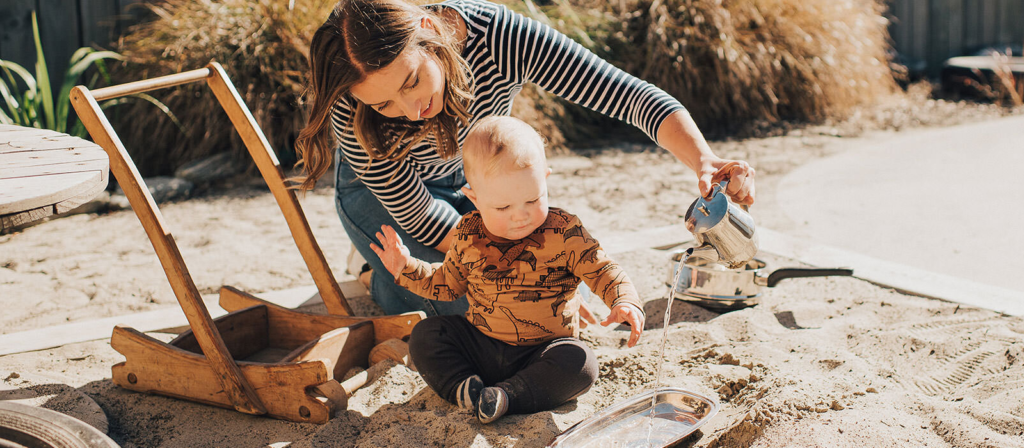
1. المراقب والمستمع أولاً
يبدأ معلم ريجيو إميليا بالملاحظة الدقيقة. فبدلاً من التدخل المباشر في التوجيه أو التصحيح، يُراقب المعلم عن كثب لفهم طريقة تفكير الأطفال، وما يثيرهم، وأسئلتهم، والنظريات التي يبدأون بتكوينها.
Through attentive listening, teachers capture the intellectual processes behind the play, identifying the patterns, hypotheses, and relationships children naturally explore. These observations then guide the planning of future activities and the design of the learning environment.
This approach demands a high level of professional sensitivity. Teachers are not imposing a lesson plan; they uncover one already within the children.
2. الباحث المشارك والمتعاون
في صف ريجيو، ينخرط المعلمون في التعلم مع الأطفال. يتشاركون في البحث، ويطرحون أسئلة مفتوحة، ويجرون تجارب على المواد، ويتأملون في الاكتشافات معًا. هذا يضع المعلم في موقع الشريك في البحث، وليس مجرد مرشد.
Rather than “delivering” knowledge, teachers encourage children to build their understanding. For example, if children wonder why rain makes puddles, the teacher might suggest they collect water on different surfaces, draw what they see, or build a water table. The teacher is not to give them the answer, but to extend their thinking.
This shared inquiry creates a culture of mutual respect. Children feel their voices matter because adults aren’t telling them what to think — they think with them.
3. الموثق والمتواصل
A unique and vital responsibility of the Reggio Emilia teacher is documentation. Teachers record children’s dialogue, photograph their work, and reflect on the learning process. This is not simply for assessment. It is a way to make learning visible, shareable, and open to reflection.
Documentation allows teachers to revisit ideas with children, track development over time, and communicate meaningfully with families and colleagues. These records become part of the learning environment. They are displayed on walls, included in portfolios, and used during parent-teacher conversations to deepen understanding and collaboration.
Through documentation, the teacher reinforces the value of each child’s thinking while engaging in continuous professional self-evaluation.
المعلم في منهج ريجيو إميليا ليس سلبيًا، لكن قوته لا تنبع من السيطرة، بل من الاهتمام والفضول والاحترام. فهو يرشد بالمتابعة، ويُعلّم بالاستماع، ويقود بالتعلم.
إنه دورٌ مُلِحّ، ولكنه في الوقت نفسه مُجزٍ للغاية. عندما يُشارك المعلمون في بناء المعرفة، يُمكّنون الأطفال من تولي مسؤولية تعلمهم، ويكتسبون الثقة اللازمة لاستكشاف عالمهم بهدفٍ ودهشة.
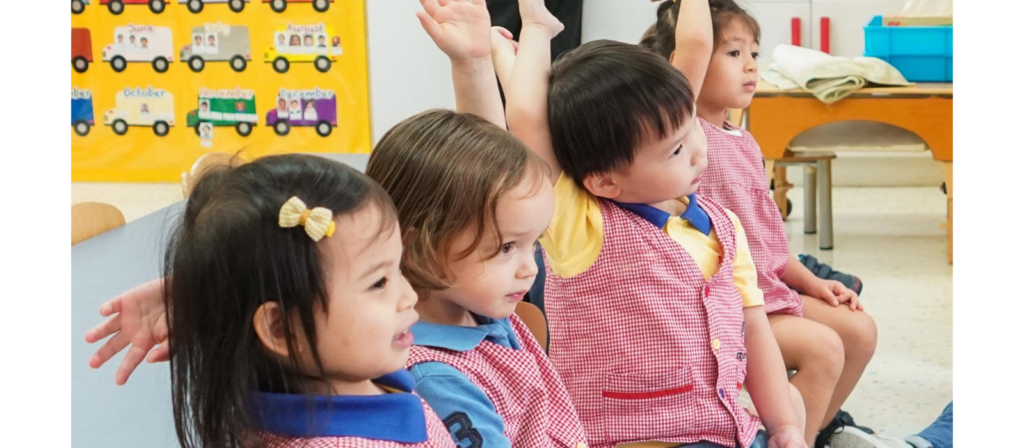
التقييم والتوثيق في نهج ريجيو إميليا
In the Reggio Emilia Approach, assessment is not a test at the end of a unit or a checklist of skills. Instead, it is a continuous, qualitative, and collaborative process known as documentation. This approach honors the complexity of children’s thinking by making their learning visible to themselves, teachers, and families.
1. التوثيق كأداة للتعلم
Teachers in Reggio Emilia classrooms systematically observe children’s interactions, questions, creations, and conversations. They capture these moments through written notes, audio recordings, photographs, video, and children’s work samples.
But documentation is not simply collecting evidence; it’s interpreting and reflecting. Educators use these artifacts to analyze how children construct knowledge, what theories they develop, and how their ideas evolve. It also helps identify new opportunities to extend inquiry.
تُحوّل هذه العملية التقييم إلى أداة ديناميكية لتطوير المناهج الدراسية، إذ يؤثر التوثيق بشكل مباشر على التخطيط المستقبلي. وتدعم هذه العملية نموذجًا يكون فيه التدريس متجاوبًا، لا مُعدًّا مسبقًا.
2. جعل التعلم مرئيًا
A key purpose of documentation is to make children’s thinking and learning visible, not only to teachers but also to children and families. Visual displays that include photos, transcripts of dialogue, and project boards are commonly found throughout Reggio-inspired environments.
When children see their words and work displayed on the walls, it affirms their ideas and supports metacognition. This ability to reflect on their own learning helps them revisit past thinking, make meaningful revisions, and form new connections that deepen understanding.
For parents, this visibility builds trust and deepens involvement. Rather than waiting for end-of-term reports, they are regularly invited into the learning journey through exhibitions, journals, and shared reflections.
3. إعادة النظر في التقييم التقليدي
يرفض نهج ريجيو إميليا عمدًا الاختبارات الموحدة والدرجات والمعايير الصارمة في مرحلة الطفولة المبكرة. فبدلًا من سؤال "ما النتيجة التي حققها الطفل؟"، يسأل معلمو ريجيو:
- ما الذي يثير فضول الطفل؟
- كيف يفهم الطفل العالم؟
- ما هي المهارات التي تظهر من خلال تحقيقاتهم؟
- ما هي القيم التي يتم التعبير عنها من خلال اختياراتهم؟
This shift from evaluation to interpretation respects the complexity of learning. It values not what a child has memorized but how they think, question, collaborate, and create.
It also demands more from educators. Adequate documentation requires time, focus, and professional insight. However, the reward is a more authentic and holistic view of each child’s development.
In the Reggio Emilia Approach, assessment is woven into the fabric of daily life. It is not something done to children, but something done with them. It becomes a shared reflection on learning that fosters deeper insight, strengthens relationships, and supports a culture of continuous growth.
It is not about measuring learning. It is about seeing it, honoring it, and building upon it.
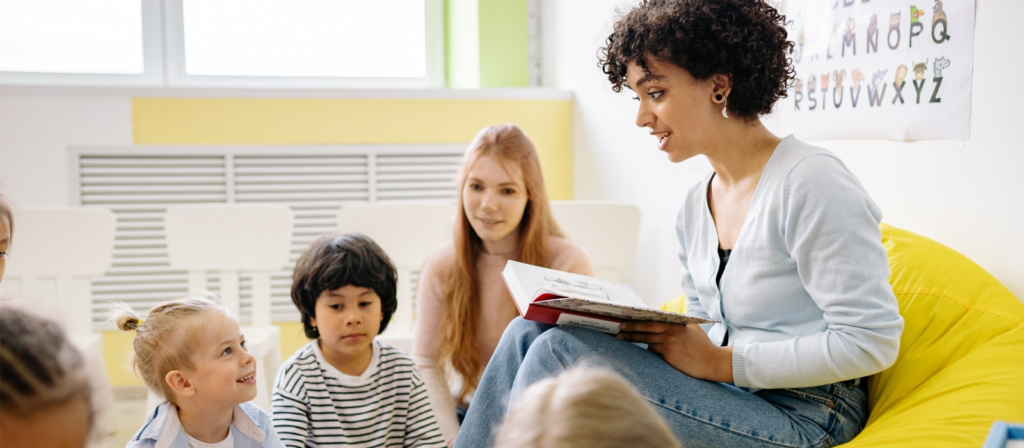
هل أنت مستعد لتصميم مساحة تُلهم التعلم؟ تواصل معنا لتصميم حلول أثاث مُخصصة تُلبي احتياجات صفك الدراسي.
الشراكة بين الوالدين في نهج ريجيو إميليا
One of the Reggio Emilia Approach’s most distinctive and potent features is its view of parents not as clients or passive observers but as active partners in their child’s learning journey. This deep commitment to family involvement is not a side note but a core pillar of the philosophy. The school, the teacher, and the parent form a triangle of trust, each playing a vital role in shaping the child’s development.
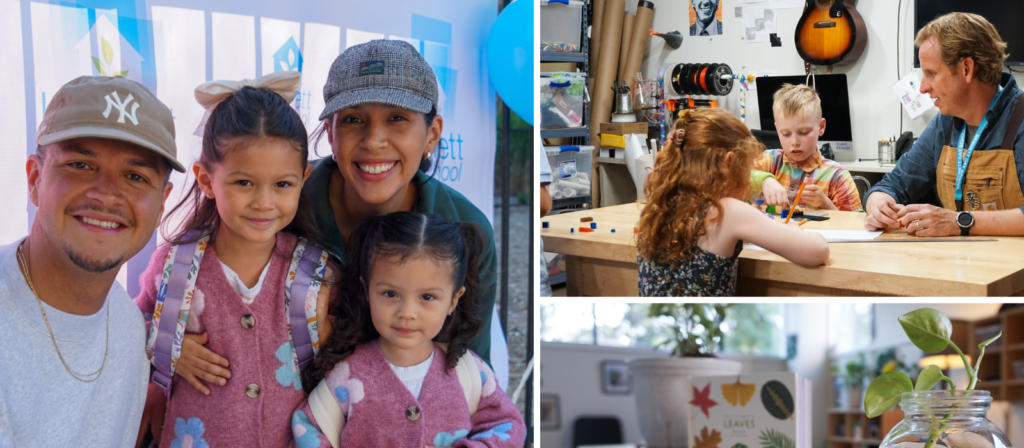
1. الآباء والأمهات كمعلمين مشاركين
In Reggio-inspired schools, parents are seen as the first and most influential educators in a child’s life. Rather than being told what the school is doing, families are invited to participate in shaping the learning environment and curriculum.
وقد يشمل هذا:
- حضور المناقشات المنتظمة واجتماعات التخطيط مع المعلمين
- المساهمة في تقديم المواد أو القصص من المنزل لإثراء مشاريع الفصل الدراسي
- المشاركة في معارض أعمال الأطفال
- Helping co-document or interpret their child’s thinking
This collaborative approach builds mutual respect and allows educators to better understand the cultural, emotional, and intellectual context each child brings to the classroom.
2. التواصل الشفاف والتأمل المشترك
A hallmark of the Reggio Emilia Approach is its use of documentation to promote open and transparent communication with families. Teachers share learning journals, photo displays, transcribed conversations, and even video snippets not as proof of productivity, but as windows into the child’s mind.
نشجع أولياء الأمور على التأمل في هذه الوثائق، وطرح الأسئلة، وتقديم الرؤى، ومشاركة الملاحظات المنزلية. يُسهم هذا الحوار المتبادل في تحقيق الاتساق بين قيم المدرسة والأسرة، مما يجعل الطفل يشعر بمزيد من الأمان والدعم في كلا البيئتين.
Regular parent-teacher meetings in Reggio settings are less about performance and more about shared meaning-making, understanding who the child is, what excites them, and how to support them as a team.
3. بناء المجتمع من خلال التعاون
The Reggio Emilia philosophy extends beyond the individual classroom. It actively fosters community among families, encouraging collective ownership of the educational space. Parents may work together on projects, school-wide installations, or cultural celebrations.
Many Reggio schools even include parent spaces within the school, where families can meet, share coffee, or exchange ideas. This physical integration signals a more profound truth: families are not visitors, but respected learning community members.
The result is a culture in which children see that learning is not confined to school walls. They feel the support of a larger, interconnected web of adults who listen to them, learn from them, and grow with them.
In the Reggio Emilia Approach, partnering with parents is not just beneficial but essential. When families and educators collaborate authentically, the child stands at the center of a strong, supportive network. This foundation enhances learning and builds the kind of trust, empathy, and shared responsibility that defines a truly human approach to education.
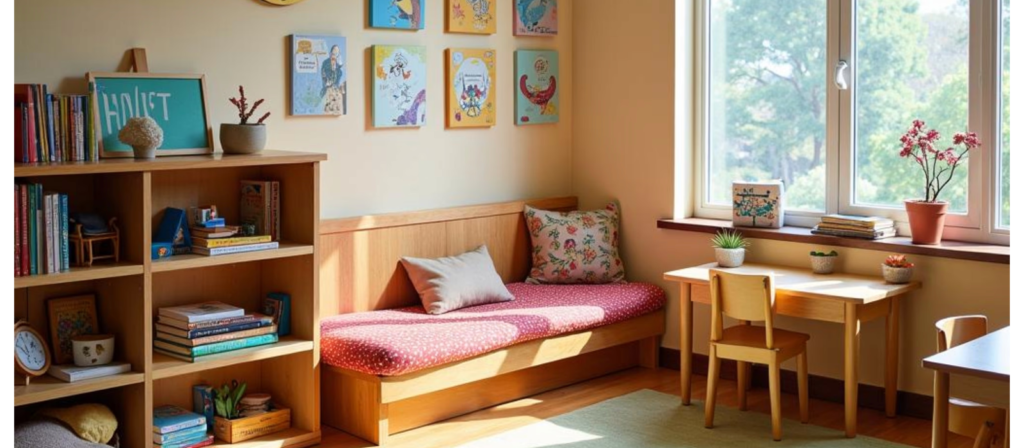
تطبيق نهج ريجيو إميليا في المنزل
لا يقتصر نهج ريجيو إميليا على المدارس فحسب، بل يُمكنه أيضًا إحداث نقلة نوعية في كيفية تعلم الأطفال ونموهم في المنزل. بالنسبة للآباء ومقدمي الرعاية، فإن تطبيق مبادئ ريجيو في المنزل يعني تهيئة بيئة يشعر فيها الأطفال بالاهتمام والاحترام وحرية الاستكشاف. لا يتطلب ذلك مواد باهظة الثمن أو استوديو مخصصًا، بل مجرد خيارات مدروسة، ومساحة مفتوحة للإبداع، وعقلية تُقدّر الطفل كمتعلم كفؤ وفضولي.
1. إنشاء بيئة مرنة وملهمة
ابدأ بإعادة التفكير في المساحة المادية. في المنازل المستوحاة من أسلوب ريجيو، تُعتبر البيئة بمثابة المعلم الثالث. يمكنك إنشاء مناطق تعلم صغيرة ومرنة باستخدام ما لديك بالفعل - ركن للرسم، ورف للقطع غير المترابطة والمواد الطبيعية، وطاولة للبناء أو الفرز.
اجعل المواد مرئية وسهلة الوصول. استخدم سلالًا أو رفوفًا مفتوحة ليتمكن الأطفال من اختيار ما يثير اهتمامهم. قدّم مجموعة متنوعة من المواد: ورق، طين، أقمشة، أزرار، أغصان، كرتون، أو حتى حاويات مُعاد تدويرها. هذه المواد تُشجع على اللعب المفتوح، مما يُعزز الخيال وحل المشكلات.
يمكن للضوء الطبيعي والنباتات والمرايا والجماليات البسيطة أن تُحدث فرقًا كبيرًا. فالمساحة الجميلة والمُصممة بعناية تُخبر الطفل: "هذا هو المكان الذي تُهم فيه أفكارك".
2. Follow the Child’s Interests
Reggio Emilia learning is child-led. At home, this means observing your child’s play and questions and extending those interests with gentle prompts and resources. If your child is fascinated by insects, for example, you could:
- جمع الأوراق والعدسات المكبرة لمراقبة الحشرات في الهواء الطلق
- ارسم موائل الحشرات معًا
- قم ببناء الحشرات باستخدام طين النمذجة أو المواد المعاد تدويرها
- قراءة الكتب أو إنشاء قصص حول الحشرات
The key is to avoid rushing to teach or correct. Instead, be a co-learner, explore the topic with your child, ask questions, and support their discoveries. Let their curiosity guide the direction.
3. تشجيع أشكال التعبير المتعددة
Support your child’s thinking through the hundred languages — drawing, music, movement, building, storytelling, and more. Avoid focusing on perfect results. Instead, ask reflective questions like:
- "ماذا كنت تفكر عندما فعلت هذا؟"
- "ماذا يمكننا أن نحاول بعد ذلك؟"
- "هل يمكنك أن تخبرني عن الرسم الخاص بك؟"
These questions affirm their thought process and invite deeper reflection. You can also keep a portfolio of their work, not for judgment, but to revisit and reflect on their growth over time.
Even very young children benefit from this: when you document their marks, movements, or phrases, you convey that their ideas are worth remembering.
4. بناء ثقافة الاحترام والتعاون
Implementing the Reggio Emilia Approach at home isn’t just about materials and values. Respect your child’s voice, include them in decisions, and model active listening. You can also involve them in everyday tasks like cooking, gardening, or setting up play areas, treating these not as chores but as meaningful learning experiences.
عندما يشعر الأطفال بالانتماء، يكتسبون الثقة والاستقلالية وشعورًا أقوى بالهوية. يصبح أفراد الأسرة متعاونين في التعلم، لا مجرد شخصيات ذات سلطة.
Bringing the Reggio Emilia Approach home doesn’t mean replicating a preschool. It means creating a home where exploration is welcomed, creativity is nurtured, and children are trusted to lead their learning.
حتى التغييرات الصغيرة في كيفية استماعنا ومراقبتنا وتفاعلنا يمكن أن تحدث فرقًا دائمًا في كيفية رؤية الأطفال لأنفسهم، ليس فقط كطلاب، ولكن كمفكرين ومبدعين قادرين.
هل أنت مستعد لتصميم مساحة تُلهم التعلم؟ تواصل معنا لتصميم حلول أثاث مُخصصة تُلبي احتياجات صفك الدراسي.
أنشطة نهج ريجيو إميليا
في منهج ريجيو إميليا، لا تُعدّ الأنشطة دروسًا جاهزة أو مهامًا معيارية، بل هي استكشافات هادفة تنبع من فضول الأطفال الفطري. هذه الأنشطة مفتوحة، قائمة على المشاريع، ومتجذرة في تجارب واقعية. الهدف ليس مجرد "تعليم" مادة دراسية، بل إشراك الأطفال في التفكير والتساؤل والإبداع والتعاون.
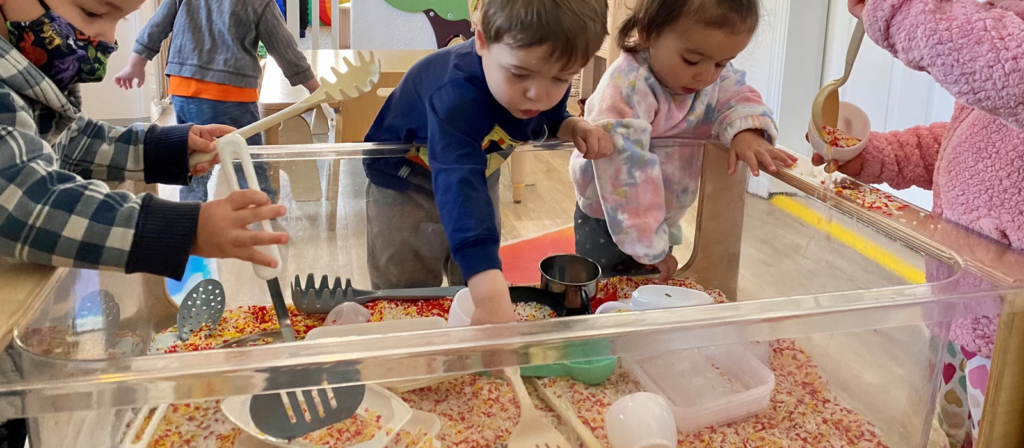
1. Nature Walk and Material Exploration
Children go on a nature walk and collect found objects such as leaves, stones, twigs, and flowers. These items are brought back to the classroom for closer examination and creative use. Children observe textures and patterns, make nature collages, or use the objects as tools in painting or printing. The experience connects them with the environment and fosters observation skills.
This activity enhances sensory awareness, builds scientific curiosity, and encourages symbolic representation. Children learn to see the world in new ways and express their interpretations through art and storytelling.
المواد المطلوبة:
- Baskets or bags for collecting
- Magnifying glasses
- Paper and pencils
- Glue and scissors
- Cardboard or canvas for collages
2. Shadow and Light Investigation
Children explore how light behaves using flashlights, mirrors, translucent materials, and projectors. They experiment by casting shadows, reflecting light, and creating moving images. As they play with shapes and shadows, they begin to develop theories about light and movement.
This activity nurtures early scientific thinking, spatial awareness, and visual storytelling. It also invites children to express abstract ideas and emotions using nonverbal forms of communication.
المواد المطلوبة:
- Flashlights
- المرايا
- White sheets or walls
- Transparent colored paper or cellophane
- Cut-out figures or puppets
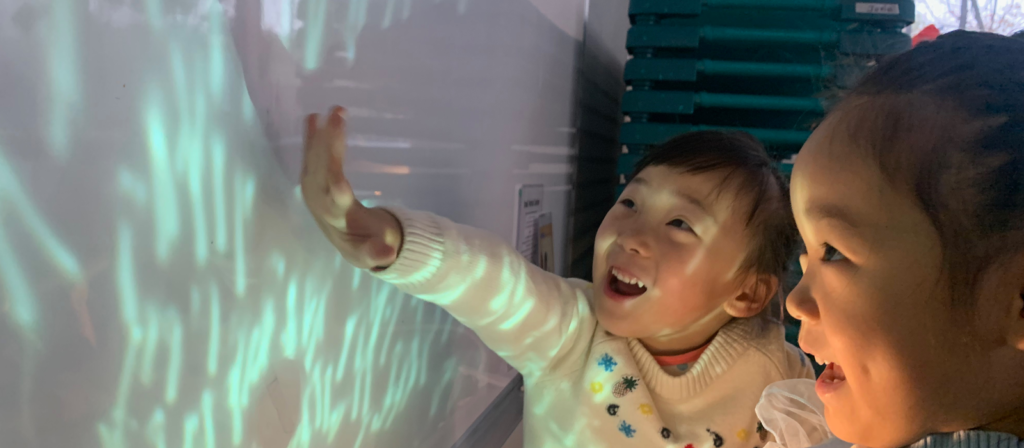
3. Collaborative Mural Painting
A large shared mural invites children to co-create a painting using brushes, hands, natural objects, or found materials. They may respond to a shared prompt or develop a spontaneous scene. Through group discussion and joint decision-making, children learn to negotiate space, ideas, and contributions.
This activity promotes cooperation, emotional expression, and creative confidence. It helps children learn how to listen to others, contribute their voice, and build a shared vision.
المواد المطلوبة:
- Large roll of paper or canvas
- Paints and brushes
- Sponges, leaves, or textured objects
- Aprons or smocks
- Tape for mounting the mural on the wall or floor
4. Building with Recycled Materials
Children design and construct with boxes, tubes, caps, and scrap fabrics. They imagine homes, cities, or fantastical creatures, experimenting with form, balance, and connection. The process is guided by their own interests, and the outcomes often evolve over days.
This activity strengthens problem-solving, fine motor coordination, and design thinking. It also teaches sustainability and encourages children to see creative potential in everyday materials.
المواد المطلوبة:
- Cardboard boxes and tubes
- Bottle caps and lids
- Glue, tape, and scissors
- Fabric scraps or yarn
- Paper fasteners or pipe cleaners
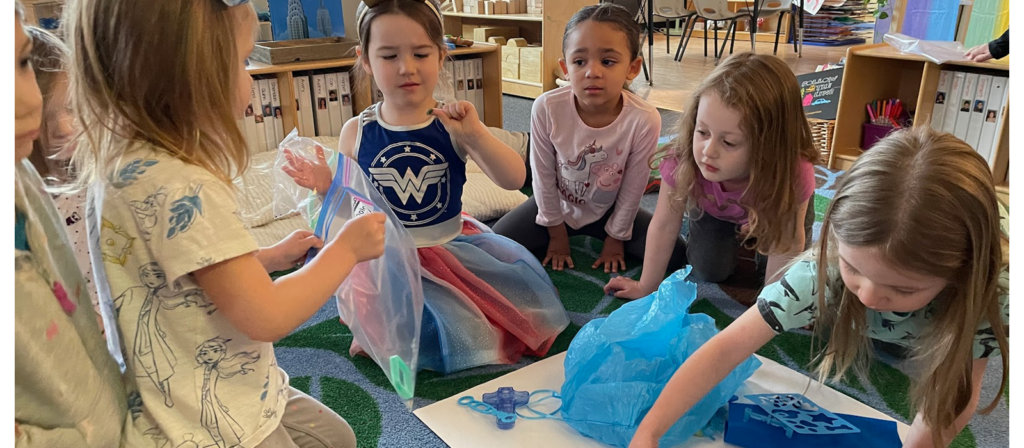
5. Story Mapping with Loose Parts
Children use small loose items to create characters and settings for original stories. They arrange materials on a mat or table and tell their story verbally, through drawing, or by recording it digitally. Each story can be revisited, altered, or expanded later.
This activity builds narrative thinking, vocabulary, and sequencing. It supports symbolic play and gives children alternative ways to express complex ideas and emotions.
المواد المطلوبة:
- Wooden blocks or discs
- Stones and buttons
- Shells, string, and felt
- Story mats or trays
- Drawing paper or digital recorder
6. Emotional Expression through Clay
Children are invited to shape clay into symbols of their thoughts or feelings. They may sculpt “what happiness looks like” or build a clay memory of a favorite place. The tactile nature of the material allows for deep sensory and emotional engagement.
This activity supports emotional intelligence, self-awareness, and mindfulness. Working with clay also strengthens hand muscles and encourages sustained concentration.
المواد المطلوبة:
- Natural clay or air-dry clay
- Clay tools or sticks
- Aprons or table covers
- Small containers of water
- Photographs or story prompts (optional)
التحديات والانتقادات الموجهة لمنهج ريجيو إميليا
While the Reggio Emilia Approach is widely admired for its innovation and child-centered values, it is not without limitations. Understanding these challenges is crucial for educators, school founders, and policymakers to make informed decisions about implementation and long-term sustainability.
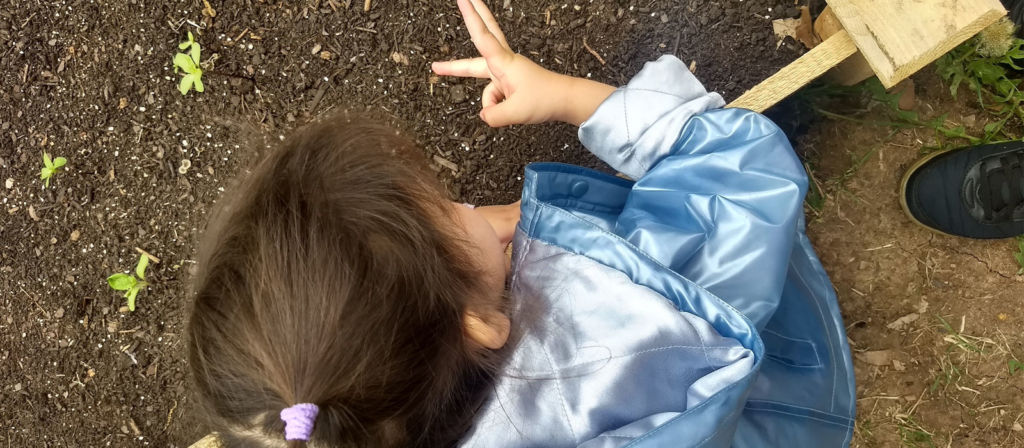
1. عدم وجود معايير موحدة
One of the most frequent criticisms of the Reggio Emilia Approach is its lack of a fixed curriculum or formal assessment system. Because learning is emergent and shaped by children’s interests, there are no preset benchmarks or standardized learning outcomes.
While beneficial in many ways, this flexibility can also make it difficult to measure progress objectively. This can be a significant barrier for school administrators or government bodies looking for consistent metrics. Teachers must rely on documentation and professional judgment rather than external testing, which can raise concerns about accountability and educational quality in some contexts.
Furthermore, without a universal framework, the quality of Reggio-inspired programs can vary widely depending on individual schools’ training, resources, and interpretation.
2. مطالب كبيرة على المعلمين
Implementing the Reggio Emilia Approach requires educators to take on multiple complex roles as teachers, researchers, documenters, designers, and collaborators. This demands high training, observation skills, and pedagogical reflection.
يُتوقع من المعلمين تكييف بيئة التعلم باستمرار، والاستجابة الفورية لأفكار الأطفال، والاحتفاظ بتوثيق مفصل لعملية التعلم. قد يكون هذا مستهلكًا للوقت ومُرهقًا نفسيًا، خاصةً في المدارس ذات الكوادر المحدودة أو نسب الطلاب إلى المعلمين المرتفعة.
Without proper support and ongoing professional development, even skilled teachers may struggle to fully realize the philosophy in daily practice.
3. البيئة كثيفة الموارد
The Reggio Emilia classroom is more than a room with tables and toys. A curated environment stimulates inquiry, autonomy, and aesthetic appreciation. Schools must invest in quality materials, flexible furniture, and thoughtful design, often using natural and real-world elements like wood, metal, mirrors, and recycled items.
Recreating this environment can be financially and logistically challenging for new or budget-limited schools. Sourcing age-appropriate, open-ended materials and continuously updating them to reflect children’s evolving interests adds ongoing operational pressure.
Documentation tools (cameras, printing, display spaces) and teacher planning time must be factored into the budget and daily workflow.
4. عدم التوافق الثقافي والبنيوي
على الرغم من أن نهج ريجيو إميليا نشأ في سياق ثقافي وسياسي إيطالي محدد، حيث كان التعاون والتمويل العام والمشاركة المجتمعية قوية، فإن نقله إلى بلدان أخرى ليس دائمًا سلسًا.
The approach may face resistance in systems where standardized testing, rigid curricula, or limited parent engagement are the norm. Some schools find it challenging to reconcile Reggio principles with external mandates, such as early literacy benchmarks or government inspections.
يتطلب التكيف الناجح غالبًا تغييرات جذرية، وليس مجرد تعديلات سطحية. فبدون هذه التغييرات، تُعرّض الفلسفة لخطر التآكل أو سوء التطبيق.
The Reggio Emilia Approach is robust but also demanding. It requires deep commitment, flexible thinking, and long-term professional development and classroom infrastructure investment.
Understanding these challenges is not a reason to reject the approach; it’s a reason to prepare well. With the right mindset and resources, many of these obstacles can be transformed into opportunities for growth.
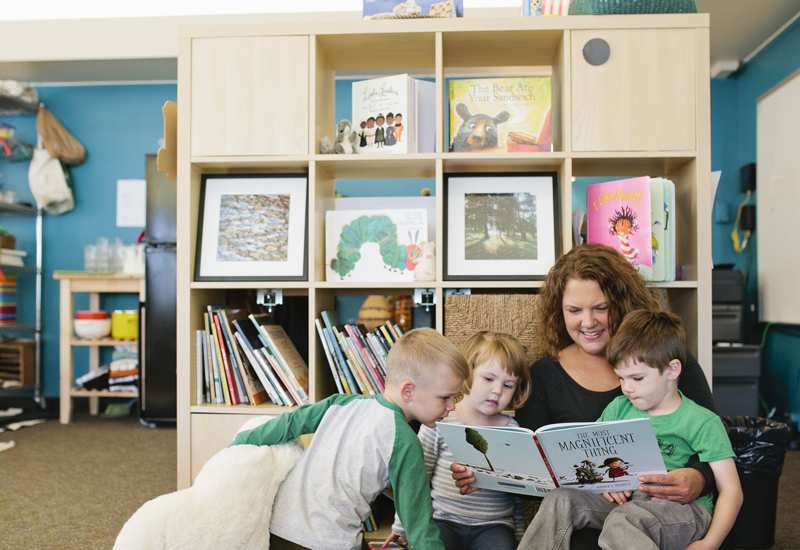

هل أنت مستعد لتصميم مساحة تُلهم التعلم؟ تواصل معنا لتصميم حلول أثاث مُخصصة تُلبي احتياجات صفك الدراسي.
خاتمة
The Reggio Emilia Approach reshapes early childhood education by placing children at the center of their learning. Through open-ended inquiry, expressive languages, and collaboration, it empowers young learners to construct meaning rather than passively absorb content. This framework doesn’t just teach, it helps children think, feel, and imagine in ways that last a lifetime.
Implementing this approach requires more than philosophy; it demands environments that mirror its values — flexible, beautiful, and built for exploration. That’s why thoughtfully designed furniture and adaptable classroom zones matter. Manufacturers like أثاث ويست شور, which specialize in early childhood furniture solutions, quietly support this vision by crafting environments that align with Reggio principles, giving ideas physical form without compromising safety, simplicity, or child-led accessibility.
The actual impact of the Reggio Emilia Approach is not in how well we recite its principles, but in how we translate them into living spaces, relationships, and daily practice. The transformation starts now for those ready to listen, observe, and build with intention.
FAQ: Reggio Emilia Approach
Q1: How is the Reggio Emilia program different from most other preschool programs?
أ: The Reggio Emilia Approach differs from other programs by emphasizing emergent, child-led curriculum, where learning arises from children’s interests rather than pre-set themes. For example:
- Unlike مونتيسوري, which uses sequenced materials and structured tasks, Reggio promotes open-ended projects with no fixed outcomes.
- Unlike HighScope, which uses a “plan-do-review” structure and emphasizes routine, Reggio classrooms are more flexible and responsive.
- Compared to Te Whāriki from New Zealand, which also values cultural context and holistic learning, Reggio places a stronger emphasis on aesthetic environment and visual documentation as part of the learning process.
To explore how Reggio compares with other major models, visit our comprehensive Preschool Curriculum overview.
Q2: What is Reggio Emilia’s famous quote?
أ: The most well-known quote from Reggio Emilia’s founder, Loris Malaguzzi, is:
“The child has a hundred languages.”
It refers to the countless ways children express themselves through art, movement, storytelling, and more.
Q3: Is Reggio Emilia evidence-based?
أ: Yes, while not a standardized model, the Reggio Emilia Approach is supported by decades of global practice, child development theory, and educational research emphasizing creativity, autonomy, and social learning.
Q4: Are Reggio Emilia schools expensive?
أ: Reggio Emilia schools can be more expensive than traditional preschools due to the low teacher-child ratios, high-quality materials, and thoughtfully designed environments. However, costs vary by region and institution.
Q5: What does a typical day look like in a Reggio Emilia preschool?
أ: A typical day in a Reggio Emilia-inspired preschool is guided by children’s interests rather than a rigid schedule. The day often begins with a morning gathering in the “piazza” (central space), followed by time for project work, where children explore topics using materials like clay, paint, blocks, or found objects.
Teachers observe and document while children collaborate in small groups, often moving between zones like the atelier (art studio), reading corners, or outdoor gardens. There are opportunities for snack time, free play, and reflection, but transitions are gentle and responsive to the children’s flow of engagement.
Every activity is seen as a chance to express, discover, and co-construct knowledge — no worksheets, rigid lesson plans, just real learning in action.

